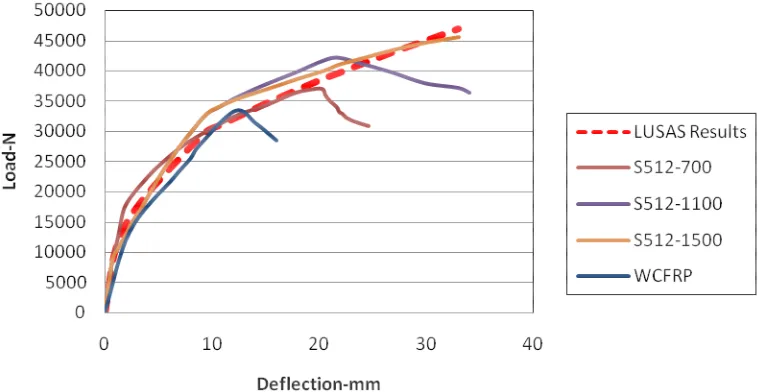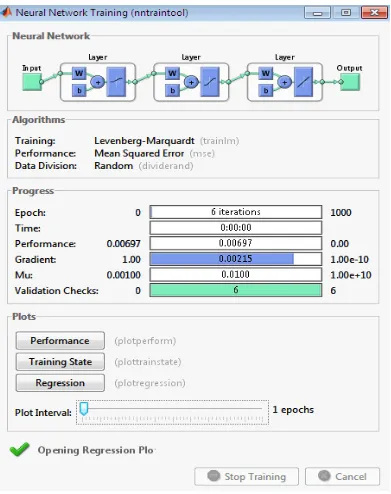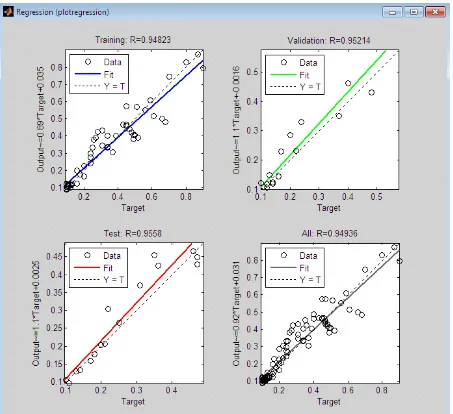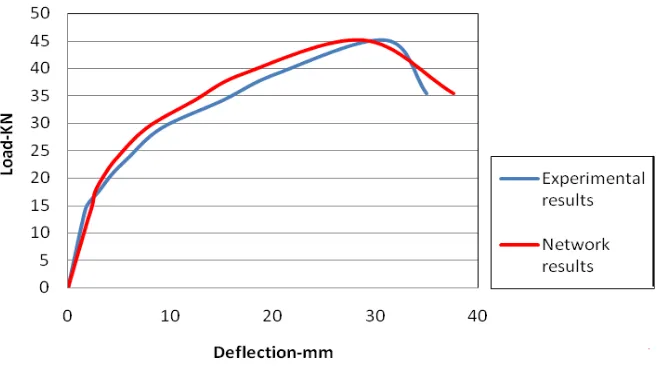Full Length Research Paper
Nonlinear analysis of load-deflection testing of
reinforced one-way slab strengthened by carbon fiber
reinforced polymer (CFRP) and using artificial neural
network (ANN
)
for
prediction
Mohammad reza halvaey far
1*, M.Z. Jumaat
2, S. Vahid Razavi T
1, Pegah Mohammadi
1, and
Hamed Mohammadi
11
Civil Engineering Department, Islamic Azad University, Dezful Branch, Iran.
2
Civil Engineering Department, University of Malaya, Malaysia.
Accepted 10 May, 2011
Load-deflection curve is the most important part of the structural analysis of RC beam and slab. The load-deflection analysis of the RC one-way slab strengthened by CFRP using experimental work, finite element analysis (FEA), artificial neural network (ANN), and a comparison of them together are the important objective of this study. The dimension of the one-way slab was 1800×400×120 mm which was strengthened by different length and width of carbon fiber reinforced polymer (CFRP). The experimental results sufficiently adapted with FEA and ANNs output. The feed forward back-propagation (FFB) was the best ANN for prediction of load-deflection curve with minimum error below 1%, and maximum correlation coefficient close to 1.
Key words: Carbon fiber reinforced polymer (CFRP), finite element analysis (FEA), artificial neural network (ANN), feed forward back-propagation (FFB).
INTRODUCTION
Damaged parts of structures require strengthening and also upgrading due to disaster or material degradation. Normally, carbon fiber reinforced polymer (CFRP) was used for strengthening of RC structures due to high strength and stiffness-to-weight ratio, corrosion resistance, utilization within various factors of design, simple organization of the surface just before applying, decreased duration of the construction time and lots of time remaining after strengthening scheme (Taljsten and Elfgren, 2000; Clarke and Waldron, 1996). CFRP has the essential requirement characteristics which make it usable for installation on the RC elements for structural behavior strengthening by considering debonding failure management (Li et al., 2005). The first crack load, final load, stiffness, ductility and CFRP stress have been carried out in an experimental work, and the finite element analyses of various length and thickness (single and dual layer) of CFRP, carried out in rectangular beam
*Corresponding author. E-mail:halvaefar2006@gmail.com
Far et al. 3055
Table 1. Application of ANN in civil engineering problems.
No. Reference Objective
1 Kasperkiewicz et al. (1995) Predicting strength of high-performance concrete- ANN
2 Ilker and Mustafa (2008) Mechanical properties of recycled aggregate concretes containing silica fume- ANN and FL
3 Yeh (1998) Modeling of strength of HPC using ANN 4 Jamal et al. (2007) R/C beams shear resistance using ANN
Table 2. The dimension of attached CFRP on the RC one-way slab.
CFRP (mm) Sample market
S512-700 S512-1100 S512-1500 S812-700 S812-1100 S812-1500
Length 700 1100 1500 700 1100 1500
Width 50 50 50 80 80 80
Thk 1.2 1.2 1.2 1.8 1.8 1.8
For the last two decades, the different modeling techniques, based on ANN systems were used by many researchers in different branches of Civil Engineering applications (Akbulut et al., 2004). Some of the applications of the ANN are explained in Table 1.
Bimal and Mutsuyoshi (2006) applied ANN models to predict the ultimate shear strength in steel fiber RC beams. The back-propagation was utilized as a learning algorithm in the feed-forward neural network. The studied on the effect of the number of input layer upon the net accuracy in regard to comparison with the analytical formulation given in literature. The analysis shows that the generated ANN with five input layers can predict the ultimate shear strength more accurately than the network with 4 input layers. Also the results show that ANN model present the underlying shear behavior very well in beam.
In other research by Jamal et al. (2007), back propagation neural network (BPNN) with different transfer functions is applied for shear resistance of rectangular R/C beams predicting and compared together. The BPNN with sigmoid function was the last iteration to pre-dict the shear strength of RC beam accurately. Kerh and Yee (2000) applied energy function as minimization key in dynamic back propagation neural networks to analyze the deformed behaviors for culvert structure under a static loading. The stiffness matrix and force vector of the structure were replaced with weighting matrix and bias vector in the neural networks calculations. Naci et al. (2007) utilized the dynamic analysis results of 165 buildings to generate a multilayer perception (MLP) with a back-propagation (BP) algorithm. Different properties in network employed to find the optimum network. The output results specified that the produced ANN can determine the 3D response of buildings subjected to earthquake as a user friendly computational tool.
METHODOLOGY
Construction of the experimental work
The slab having a similar dimension of 2800×400×120 (mm), an equal steel bar percentage of 2T10, and strengthened by different length (700, 1100 and 1500 mm) and cross section area (60 and 96 mm2) of CFRP, was tested and compared with similar samples without CFRP, and is shown in Table 2. The samples loading and instrument setup is shown in Figure 1, while the property of the used materials is shown in Table 3.
Nonlinear analysis using LUSAS software
LUSAS is a finite element analysis (FEA) software that can evaluate all kinds of complex models using linear or non linear analysis. In LUSAS software, the model geometry is defined as features which are then sub-divided into finite elements in order to do the analysis. By increasing the number of elements in the meshed member, the accuracy of the analysis is usually increased, and the time required for analysis is also increased.The elements are modeled in LUSAS software as the following statements: In considering the linear strain distribution over the depth, no slip was found between the concrete and steel bar and external CFRP, thereby the adhesive tensile strength was ignored and tensile stress was not carried by concrete after cracking. The concrete feature assumptions in the current study are as follow:
1. The first crack maximum stress in concrete is equal to
2. The strain on the ultimate concrete compressive is equal to 0.0035.
3. The relationship between stress and strain after first crack and
[image:2.612.85.541.236.301.2]Figure 1. Loading and instrument setup.
Table 3. The properties of the used material.
Material Properties
Concrete Mix ratio of 1: 1.47: 2.64: 0.5 (Cement: FA: CA: Water); Mean compressive (300 Kg/cm
2), tensile
strength (45 Kg/cm2); Elasticity (Ec = 258811 Kg/cm2)
Steel Rebar T10 ( fy = 4000 Kg/cm2), (Es = 2150000 Kg/cm2)
CFRP -Sika CarboDur- MY S 512 (width 50 mm, thickness 12 mm), (Cross section area = 60 mm2)
Adhesive Sikadur -30 m (Compressive, shear and tensile strength are 90, 17.5 and 28.6 Mpa, respectively after 7 days curing in 35°C temperature)
4. The relationship between stress and strain after and before
is defined by the following formula:
where: = stress in concrete; = ultimate stress in concrete;
= compressive strain in concrete; = strain in maximum
compressive stress, and = concrete module of elasticity.
Artificial neural networks (ANNs)
Artificial neural networks (ANNs) are extremely simplified models of biological neural systems, displaying capabilities such as learning, abstraction and generalization (Wasserman and Bentur, 1996). Neural networks are kinds of data information used to give out the method, whose architecture is enthused by the construction of human nervous structure (Caudill and Butler, 1990). Actually, the fundamental purposes of biological neurons are simulated by artificial neurons (Hawley et al., 1990).
Far et al. 3057
Figure 2.Load-deflection relationship for slab with CFRP S512 as compared to that without CFRP.
named input nodes, after which they are connected to hidden nodes by function, and finally the network output is concluded from the output layer nodes. The selection of the network type is the first and important part of modeling by artificial neural network, after which the input parameters will be selected adequately to the output data. Then, the network architecture means of the number of layers, the neurons in each layer and their connection together, the kind of transfer function for neurons, and the network training and learning function will be determined. After determining the network type and net architecture, there is need for some gathered data to generate network. The gathered data, which must be for the network generation, are divided into three phases (Ripley, 1996):
1. Training phase: Using all training data set for network learning to fit the weight of the classifier.
2. Validation phase:A set of data used to adjust the parameters of a classifier, such as the number of hidden layers and neurons in each hidden layer. Actually, in this phase, the necessary training iteration is determined to avoid overtraining.
3. Test phase: A set of data is used for full assessment of the network performance.
In the current research, Feed-forward back-propagation neural networks (FBNNs) were applied for load-deflection prediction of the plain RC one-way slab and were strengthened by CFRP. In recent years, the FBNN efficiently attracted researchers from many areas of civil engineering applications, such as prediction of compressive concrete strength (Hong-Guang and Ji-Zong, 2000), prediction of shear strength of RC beams (Mansour et al., 2004), structural analysis and design (Consolazio, 2000; Hadi, 2003), damage detection of bridges (Lee et al., 2005; Yeung and Smith, 2005), structural dynamics and control (Chen et al., 1995).
RESULTS AND DISCUSSION
Experimental results versus nonlinear analysis
Here, the results of the experimental work are compared with that of the analytical output. In Figure 2, the one-way
RC slab strengthened by CFRP S512 (width = 50 mm and thickness = 1.2 mm) and different length (700, 1100 and 1500 mm) were compared with the similar one way RC slab without CFRP. As it is considered, the experimental result for load-deflection analysis follows the result of the finite element analysis (FEA) output. By using CFRP installed on the slab structure, the value of load-deflection set (KN, mm) for the sample without CFRP changed from 33 and 12 to 37 and 19, 42 and 22, and 45.5 and 33 for 700, 1100 and S512-1500, respectively. These results indicated that by increasing the length of CFRP (such as 700, 1100 and 1500 mm), the loading capacity increased by 10.8, 21.5 and 27.5%, respectively.
The results of the experimental work on the one-way RC slab strengthened by S812 (width = 80 mm and thickness = 1.2 mm) and the different length (700, 1100 and 1500 mm) in comparison with the sample without CFRP are indicated in Figure 3. By increasing the length of the installed CFRP, the loading capacity improved by 13.2, 26.7 and 40% for 700, 1100 and S812-1500, respectively.
By increasing the CFRP cross section area from 60 (S512-1500) to 96 mm2 (S812-1500), the maximum load capacity increased from 45.5 to 55 KN (Figure 4).
Artificial neural networks
The modeling of the network consists of the following five parameters:
Figure 3.Load-deflection relationship for slab with CFRP S812 as compared to that without CFRP.
Figure 4. Load-deflection analysis comparison between the samples strengthened by CFRP512-1500 and CFRP S812-CFRP512-1500 and the samples without CFRP.
an output layer (Rajagopalan et al., 1973).
2. Network training and learning function: Training and learning functions are numerical measures used for automatically changing the weights and biases of the system.
3. Network architecture: The number of hidden layers and neurons in each hidden layer is defined in this part. The number of hidden layers can be randomly selected and changed to find the best one in each trial. Normally, one or two hidden layers with a random number of neurons should be sufficient to estimate any function (Haykin, 1994).
4. Network transfer function: An appropriate transfer function should be selected for numerical representation of the relation between the input and output of a network. Linear, threshold and sigmoid are three applicable transfer functions (Ripley, 1996).
5. Network performance function:The mean square error (MSE) was used to calculate the percentage of different values between actual and network output. The pro-perties of the selected network are shown in Table 4.
Far et al. 3059
Table 4. The network properties.
No. Parameter Property
1 Training algorithms Lonberg-Markorat
2 Network transfer function LOGSIG-TANSIG-PURELIN 3 Network architecture 3-15-5-1
4 The number of training data 87 5 The number of verifying data 24 6 The number of testing data 11
7 Network function Feed forward backdrop
Figure 6. Network submission for the RC slab strengthened by CFRP.
The minimum training error, equal to 0.00697 (less than 1%), is extracted by the MSE method from the networks and is shown in Figure 5. However, the correlation coefficient, which is equal to 0.95 in training, verification and the testing process, is shown in Figure 6. The evaluation between the experimental results and network results is shown in Figure 7. Nonetheless, the load-deflection curve, concluded by ANN, is close to the experimental output with the minimum error below 1% as the testing output error.
Conclusion
The results of the current study are summarized as follows:
1. CFRP caused improvement on the load-deflection diagram.
2. The experimental results are sufficiently adapted to FEM, and are compared together.
3. By increasing the length of CFRP (such as 700, 1100 and 1500 mm) for the slab strengthened by S512, the loading capacity increased by 10.8, 21.5 and 27.5%, respectively.
4. By increasing the length of CFRP (such as 700, 1100 and 1500 mm) for the slab strengthened by S812, the loading capacity increased by 13.2, 26.7 and 40%, respectively.
5. For the two networks, the best architecture is 3-15-5-1. 6. For the two networks, the training, verification and testing of data had minimum error below 1%.
Far et al. 3061
Figure 7. Experimental and network results comparison of slab with CFRP.
8. The feed forward back-propagation is the best network function with minimum error and maximum correlation coefficient close to 1.
REFERENCES
Akbulut S, Hasilog¢lu AS, Pamukcu S (2004). Soil Dynamics and Earthquake Engineering, 24: 805–814.
Amen A, Laurent M, Manuel L, Patric H (2008). Strengthening slab using externally-bonded strip composite. Composite, 39: 1125-1135 Bimal BA, Hiroshi M (2006).Prediction of shear strength of steel fiber
RC beams using neural networks. Construction Build. Mater., 20(9): 801-811.
Caudill M, Butler C (1990). Neural Intelligent System. MIT Press. Cambridge. Ma.
Chen HM, Tsai KH, Qi GZ, Yang JCS, Amini F (2005). Neural networks for structural control, J. Computational Civil Eng.,9(2):168–176. Christopher KY, Zhongfan C, Stephen KL (2002). Effect of size on the
failure of FRP strengthened reinforced concrete beams. Adv. Build. Technol., 797-801.
Clarke JK, Waldron P (1996). The reinforcement of concrete structures with advanced composites. Struct. Eng.,74: 1996.
Consolazio GR (2000). Iterative equation solver for bridge analysis using neural networks. Computer-Aided Civil Infrastructure Eng., 15(2): 107–119.
Hadi MNS (2003). Neural network applications in concrete structures. Comput. Struct. Elsevier Sci. Ltd, 81: 373–381.
Hawley DD, John DJ, Dijjotam R (1990). Artificial Neural System: A New Tool Financial Decision Making. Fin. Anal. J., pp. 63-72. Haykin S (1994). Neural Networks: A Comprehensive Foundation.
Macmillan College Publishing Company Inc. New York. United States.
Hong-Guang N, Ji-Zong W (2000). Prediction of compressive strength of confined concrete by neural networks. Cement Concrete Res. Elsevier Sci., Ltd. 30: 1245–1250.
Ilker BT, Mustafa S (2008). Prediction of rubberized mortar properties using artificial neural network and fuzzy logic. J. Mater. Process. Technol., pp. 108–118.
Jamal AA, Elsanosi A, Abdelwahab A (2007). Modeling and simulation of shear resistance of R/C beams using artificial neural network. J. Franklin Institute, 344(5): 741-756.
Kasperkiewics J, Racz J, Dubrawski A (1995). HPC strength prediction using ANN. ASCE J. Comput. Civil Eng., 9: 279–284.
Kerh T, Yee YC (2000). Analysis of a deformed three-dimensional culvert structure using neural networks. Adv. Eng. Software, 31(5): 367-375.
Lee JJ, Lee JW, Yi JH, Yun CB, Jung HY (2005). Neural network-based damage detection for bridges considering errors in baseline finite element models. J. Sound Vib., 280: 555–578.
Li LJ, Guo YC, Liu F, Bungey JH (2005). An experimental and numerical study of the effect of thickness and length of CFRP on performance of repaired reinforced concrete beam, Construction Building Mater., 20: 901-909.
Mansour MY, Dicleli M, Lee JY, Zhang J (2004). Predicting the shear strength of reinforced concrete beams using artificial neural networks. Engine. Struct., 26: 781–799.
Naci C, Muzaffer E, Zeynep DY, Mehmet S (2007). Neural networks in 3-dimensional dynamic analysis of reinforced concrete buildings. Rajagopalan PR, Prakash J, Naramimhan V (1973). Correlation
between ultrasonic pulse velocity and strength of concrete, Indian Concrete J., 47(11): 416–418.
Ripley BD (1996). Pattern recognition and neural networks. Cambridge University Press. New York.
Smith ST, Kim SJ (2008). Strengthening of one-way spanning RC slabs with cutouts using FRP composites. The University of Hong Kong. University of Technology Sydney, Australia.
Taljsten B, Elfgren L (2000). Strengthening of concrete beams for shear using CFRP-materials: Evaluation of different application methods. Composites. Part B. Eng., 31: 87-96.
Wasserman R, Bentur A (1996). Interfacial interactions in lightweight aggregate concretes and their influence on the concrete strength. Cement Concrete Composites, 18: 67-76.
Yeh IC (1998). Modeling of strength of HPC using ANN. Cem. Concr. Res., 28: 1797–1808.





